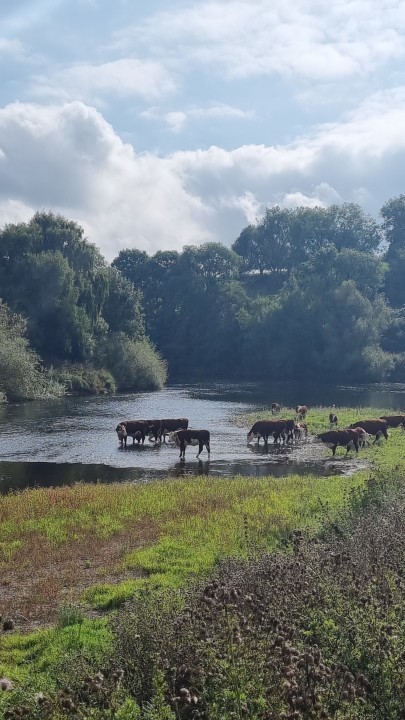 Caradoc - MH from Wolverhampton
Caradoc - MH from Wolverhampton Late August for me was one of those times when, for some reason or another, there was nothing much urgent to do. Business would be quiet until we got into the new month. It was almost like being retired. And what’s more, the rivers were in condition; it had been raining and one could envisage picking up a salmon. So I had a couple of early mornings to myself, one on the lower Usk and one on the Wye, leaving home in the mists before dawn and arriving at the river as the sun spread its red light and certainly before any other angler.
On each occasion I fished down predetermined pools, casting as long and as straight a line as I could over water which looked close to perfect, even if slightly coloured. I paid attention to every known lie. And of salmon I saw not a sign! I was home well before lunch, with a slight feeling of irritation that such early rising effort on my part should really have been rewarded with a fish. A more determined man than me might have flogged away all day and perhaps been rewarded at the end. “Keep your fly in the water,” as they say, but I’m older and more easily tired these days and have the idea that if a salmon can’t make the effort during the morning, I’m not going to keep at it for 12 hours and exhaust myself during the afternoon going over the pools again and again. After all I have some pride!
On the third morning therefore, the 15 foot double-handed rod remained hung up to dry in its bag and it was the tube with the little 7 footer which was stowed away in the back of the car. I was off to the Bideford Brook, on another cloudy and rainy morning, for a very different experience. The stream was up, just a couple of inches, and had a tinge of colour, but nothing looking like a flood. I slipped in through the alder trees at the bottom with a little Rusty Klinkhammer on a 7 foot leader and began to flick it up the runs. There seemed to be troutlets looking up and ready to rise everywhere, both in the runs and the occasional deep pools. After fishing this stream in a shrunken condition during the drought, it was surprising now that it was in condition, to be reminded just how many trout it contains.
Where I couldn’t see the fly in rippled water under a dull light, I struck to the splash on the surface when I heard it. I seemed to be releasing fish one after the other. They weren’t all little trout either. There were a couple of 12 inch fish in the catch, to go along with the babies. One of these came from a very overgrown hole which is difficult to get the fly into and before netting there was some drama when it wrapped the line around trailing brambles.
I had reached a count of 24 trout when it all came to an end. The reason being that as I rounded a corner and readied myself for the first cast into a new pool, four dogs of different breeds and sizes suddenly arrived on the bank and jumped with joyous splashes into the middle of it. I stood still in the river and watched as their owner, a lady of a certain age, arrived and proceeded to heave in three or four logs to add to the turmoil. The water was boiling like a cauldron with wet and plunging dogs. Well, I can be as sarcastic as the next man. I coughed to draw her attention, doffed my hat, and followed to the word Oliver Kite’s famous example: “Good morning madam. And tell me, have you come far to do this?”
“Oh my goodness, I’ve ruined it for you, haven’t I?”
Well of course she had, along with all the water above which her dogs had been playing in. But, to be honest, I realised she genuinely hadn’t seen me, and probably hadn’t envisaged that anybody might be fishing. I told her not to worry; I live locally and get to fish here all the time. Which is quite true and I had already enjoyed a really nice morning. Coffee was waiting in the car.
I fished the Forest of Dean’s Cannop Brook another day, and that was fun too, with 10 little trout to show for it, again taken with the small Klinkhammer. I was a bit shocked however, by the damage done by storms earlier in the year, and the number of full grown trees which have fallen across the stream. I counted more than 30 new ones. About 7 or 8 years ago, Forest England carried out a thinning operation in these woods and at the time made a point of consulting the WUF on how the environs of the stream should be treated. The brook and its banks have never looked so neatly kept, either before or since. Fallen tree trunks are beyond my winter trimming efforts, so will have to wait until the next time Forestry England decides to intervene, but even now at least 2/3 of the stream can be fished and the resulting woody debris does nothing but good for the fish population, which currently seems quite healthy.
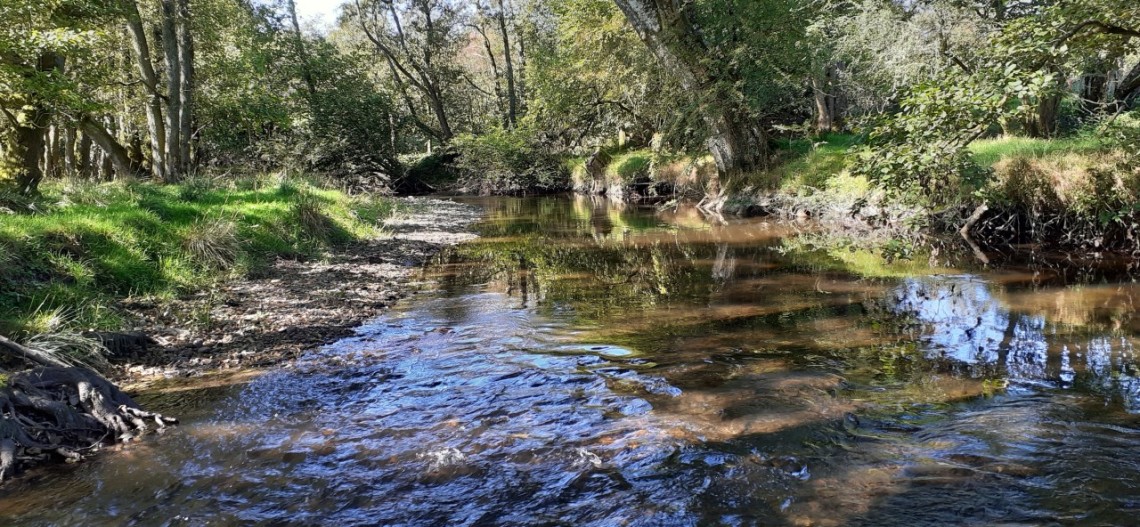 Clywedog - JA from Rhayader
Clywedog - JA from Rhayader Other salmon anglers did better than I as we came to the end of August. On the last day of the month Steve Boswell had an 8 pounds coloured fish on a Bann Special in the Ross and Wye club’s Weir End water. One of my clients, Patrick Batten from London, hooked and lost a salmon in Goodrich Court’s Vanstone Pool. Nigel Smith had an 18 pounds fish from Spreadeagle’s High Bank, while Lea Devereux of Hereford had a 15 pounds cock fish at Llangoed and Lower Llanstephan. Robin Stewart reported a pair of fish, 10 and 14 pounds, taken on a small Cascade tube at Redbrook. Wyesham reported fish of 10 and 15 pounds on a Mepps spinner and another of 14 pounds on the first day of September, while Alex Revill had one of 12 pounds at Upper Bigsweir.
Some coarse fish anglers had problems to report. AP from Blandford Forum with three friends had 8 barbel and 2 chub at the Home Fishery, but they were restricted by a lack of strimming thus leaving some swims inaccessible. This has been a common complaint in many places during a summer season in which growth of every kind of obstructing weed seems to have been exceptional. Blame this year’s weather and rainfall if you will for the rapid growth, but given the price of main river day tickets, it’s not unreasonable to hope for some maintenance efforts to keep the brambles down. Some of these beats must be taking a considerable income. OR from Wadebridge in Cornwall had an unexpected experience when arriving for some evening fishing at Goodrich Court; a swarm of bees had made it too dangerous to open the main gate. Better news came from GW of London who fished the Darlington Brown Trout AA’s stretch of the Tees and caught 4 trout and 3 grayling: “This stretch is heaven, beautiful day…”
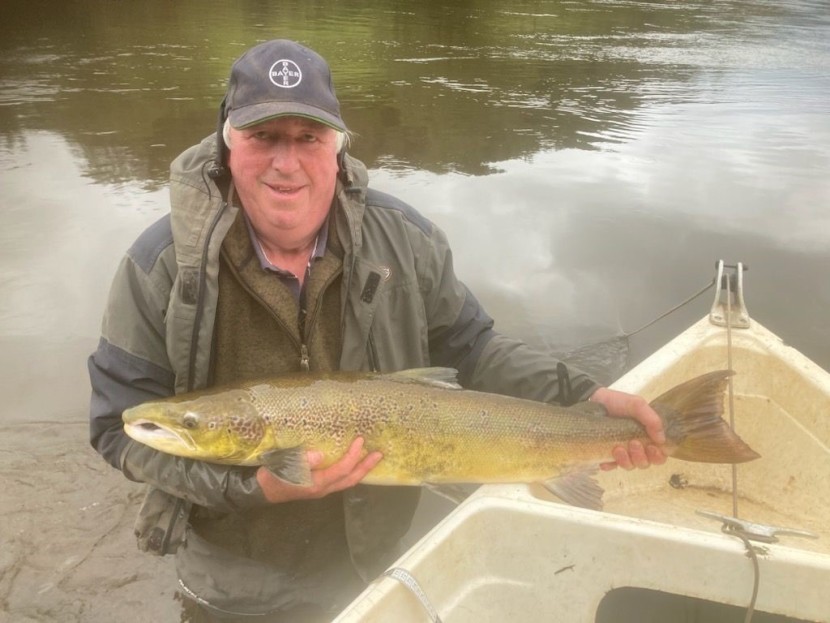 Wyesham 22 pounds cock fish
Wyesham 22 pounds cock fish 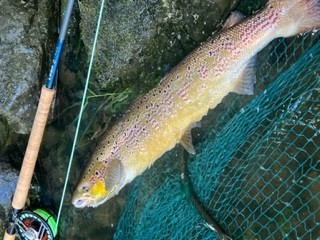 Chapel Catch salmon - AW from Worcester
Chapel Catch salmon - AW from Worcester One little gem I picked out from the upper Wye reports, which is that the Griffin at Llyswen is making a name for itself by serving home-made pizzas from a wood-fired oven. For me, that would finish the day nicely. And again AW from Ledbury’s report on fishing for two on the Arrow’s Hergest Court (4 trout) recommended “Steve Bull’s ham pies from Much Marcle produce market.” Along with cider, that took care of their lunch. CH from Bridport fished at Strangford for 2 barbel and 30 chub. SLV from Windsor was not so happy with 3 chub caught at White House, where he felt the access was good but : “…fishing was like watching West Ham United, full of hope, but a little crap.” I don’t know much about football, but I think I can follow what he is getting at there. MH from Swansea, a member at Gromaine, found the river too low for salmon, but caught 12 trout and 20 grayling on spiders and nymphs. Joe Alexander from Rhayader was again addressing the WUF’s habitat team, this time asking them to deal with a fallen ash tree on the Edw at Hundred House. He caught 9 trout during this visit and a dozen more a couple of days later from the Clywedog, and had yet more to say in his report on the subject of Wild Stream cleaning. AS from Collingham struggled to fish the tiny Dulas Brook (a Monnow tributary) in low water. This really is one of our smallest Wild Streams: “You would find a spot or two where you can throw a roll cast but otherwise it’s all going to be bow and arrow.”
Lyn Davies of Swansea accompanied by photographer Sara, both good friends of mine, had an excellent day at Doldowlod on 3rd September, this being just before a late heat-wave hit us. It’s tricky wading on the rock stream-bed there, but he had 6 trout and 21 decent grayling, using both dries (a little Red Tag I gather) and nymphs. The following week was very hot by UK standards, a heat-wave rather than merely an Indian summer, with temperatures approaching 30 degrees. This led to an extension of the “silly season” as you might imagine. JB from Bridgend fished the Abergavenny Town Water and complained: “…by 1300-1400 hrs the accessible parts of the river were unfishable due to the number of people and dogs in the water.” MT from Orpington who had a salmon ticket on the Dee reported: “Didn’t fish as water temperature was about 18 degrees.” GW from Cheltenham had problems with the access to the River Lugg at Eyton, particularly as the footpath suspension bridge has been declared unsafe and blocked off. I believe this little bridge has been out of bounds for about a year now and having wobbled my way across its rather flimsy structure many times in the past, I can well believe that the county engineers find it to be unsafe. Still, unless or until it is repaired or replaced, fording is now the only way to cross the river. Joe Alexander of Rhayader reported suspicions about pollution on the Duhonw, this time with suggestions that the WUF should investigate. AS from Collingham had 10 trout with a Parachute Adams from the upper beat of the Cammarch near the Trout Inn, although the access somehow involved jumping over barbed wire fences. Coarse fishing was standing up well despite the heat, as you might expect. JT from Newbury with a friend caught 5 barbel and 45 chub from Holme Lacey 3 and Lechmere’s Ley. However, as water temperatures rose by 7th September the Foundation took a decision to suspend game fishing, trout, salmon and pike, on both main rivers below Builth and Brecon respectively.
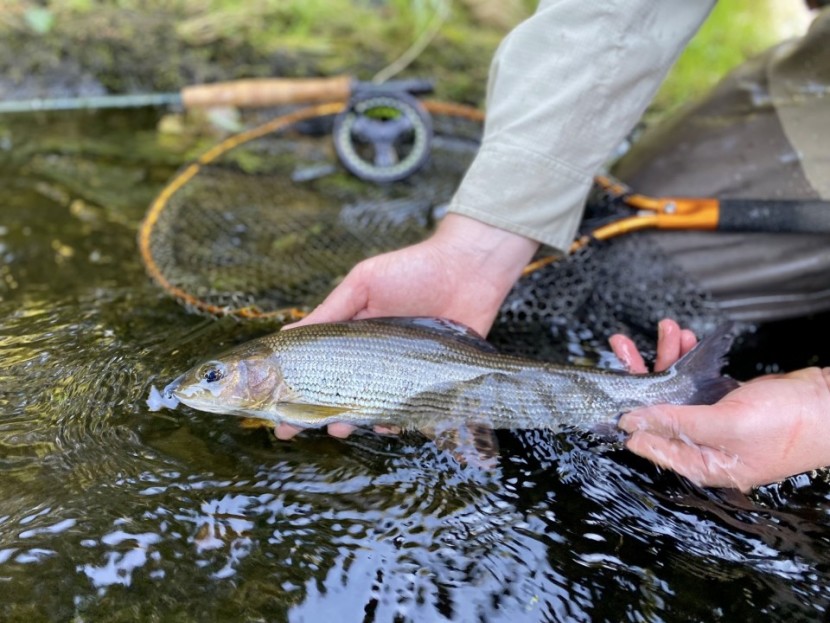 Doldowlod grayling - LD from Swansea
Doldowlod grayling - LD from Swansea 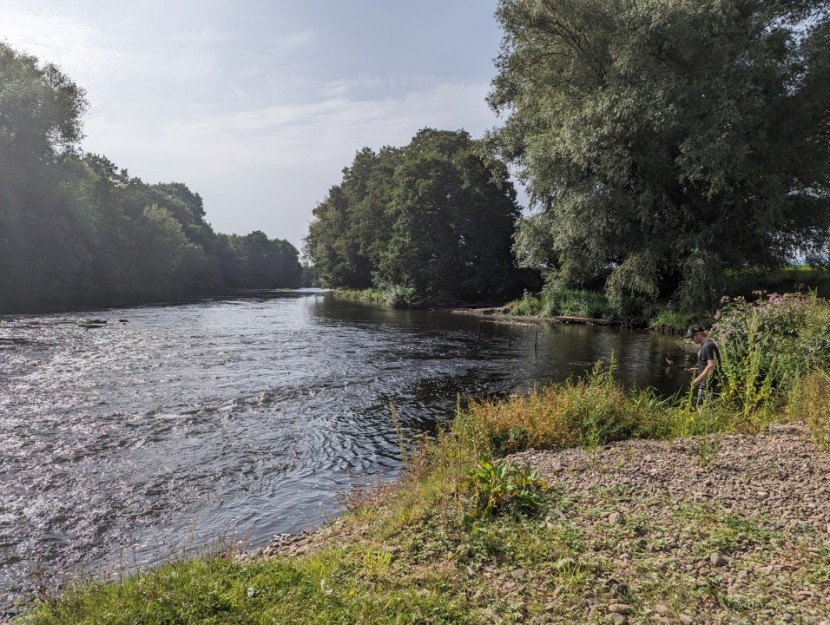 Greeenbank - JH from Bristol
Greeenbank - JH from Bristol Over in Wiltshire, water temperatures were reasonable enough by comparison but the Heale Estate’s keeper Peter Major was worrying about the weed cutting. Following a fatal accident with a collection boom in the North, the EA has suspended co-ordinated weed cutting operations on the chalk streams, with the exception of the Test. Fishery owners were left to their own resources, but as the end of the season neared uncut weed beds almost blocked water courses and led to unnaturally high water levels. In the valley of the Avon, the whole chalk stream and carrier system depends on seasonal weed cutting and has done for centuries. There was even a concern that if growth continues unchecked, when the winter floods come the massive ranunculus beds will be dragged out by the roots, thus being entirely lost and so proving difficult to re-establish.
Peter was engaged in a plan along with the local fisheries around Heale, all of which was to be enacted on a single day. Below the Turbine hatches Peter, hopefully with help, would be out on the shallows hand scything weed which should drift down together with the cuttings from the fishery below, finally after 3 miles to be deflected by weed racks and corralled in a particular carrier where a boom would be deployed. There a machine would be stationed to grab out the masses of cut weed and fill trailers which would be towed off to a local farmer who wanted it for fertiliser on his fields. At the same time a weed cutting boat contracted for the day would be cutting the upper mile above the Turbine hatches to the village, a deep stretch which is particularly heavily clogged this year with different species of ribbon weed and encroaching sedges. All this, hopefully, would also drift down and run through the half-open Turbine hatch to join the rest. Or might it cause a block and jam in the hatch, potentially to flood all the upper meadows? Opening the hatches fully to increase flow was not an option. The water level above the Turbine needs to be kept constant in order to feed cool water to three trout stew ponds, a system of long concrete channels which was originally designed by Frank Sawyer. Thousands of young brown trout would be at risk should the flow through the stews cease. Peter was organising men to stand by the hatches through the day and was ready to stop the whole operation if a blockage occurred.
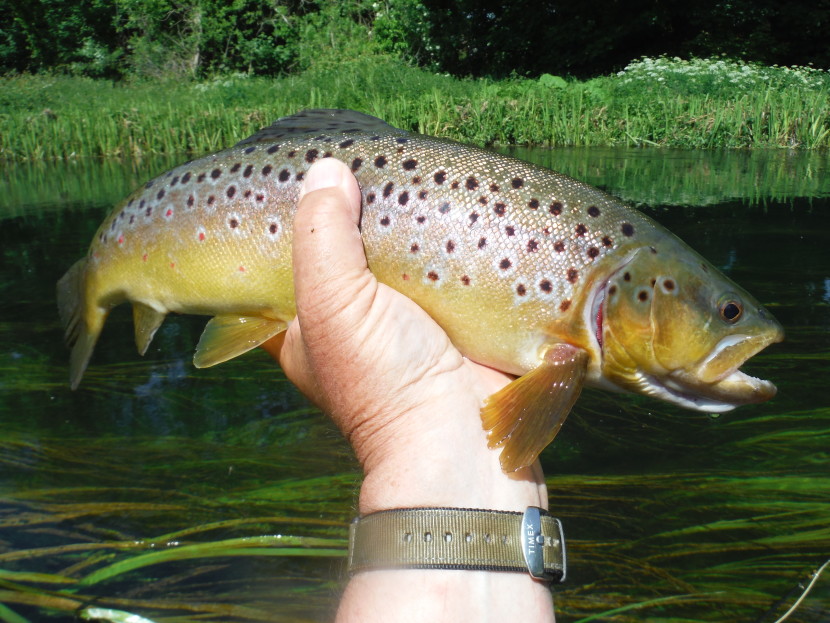 Avon stock fish
Avon stock fish 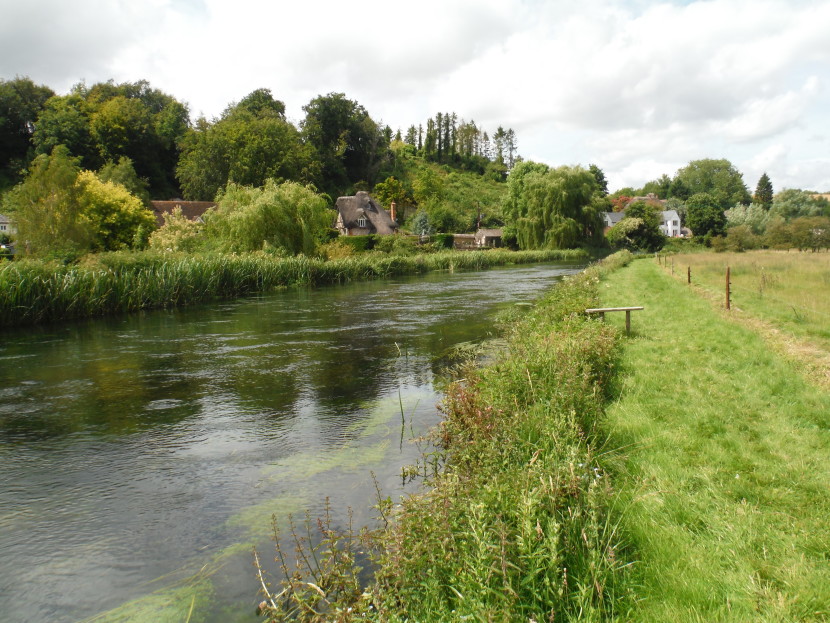 Woodford village
Woodford village Leaving Peter to his worries for a while, we decided to fish around and in between the Avon’s ranunculus beds as best we could. On a humid and cloudy late season day, David Burren and I turned up at Heale to find very few fish rising. Nevertheless, I started with a dry Parachute Adams and finessed a couple of wild ones out of a hatch pool in one of the carriers. After that I moved to the main river where the big trout were clearly not much concerned to rise and so I changed to a tiny Pheasant Tail nymph tied with a copper coloured tungsten bead. I love the PTN, that inspired creation of Frank Sawyer, and I think the general colour scheme of dull red and coppery brown is perfect. You don’t hear so much about the Netheravon School of nymph fishing these days, such is the concentration on the European method of heavy and close nymph fishing with long sensitive rods, but in clear chalk streams it still has its place. It also has the great advantage that only a change of fly is needed when changing between dry fly and nymph; the rest of the tackle including the leader is much the same, provided the leader butt is well greased. The only modern innovation is the tungsten bead, which I am sure Frank Sawyer and Oliver Kite would have used if they had been available. There is a limit to the depth you can reach with copper wire alone, but with a small tungsten bead on a 16 hook and a long leader it was possible to achieve several things. In the deep slow moving water between the plane trees and the Brick Bridge, with the unseen nymph probably 5 feet down, I saw a sudden tense where the greased leader butt lay on the surface, and struck into one of the big stock fish, the presence of which I had only guessed at. Having released that one, there was a rise further upstream, close under my own bank in shallower water where a drowning ditch joins the river. I am continually surprised how close the big fish come to the open meadow bank of this pool rather than staying under the sheltering branches of the plane trees. I got a take from this one, but failed on the strike, merely turning it over. Further up in the head of the same pool, several small and one large trout could be seen over the gravelled gap between weed beds. I sent the nymph up there while thinking that, knowing my luck, one of the small ones would have it first. However, it turned out that for once the bigger fish, a 2.5 pounder, beat the others to the nymph before streaking all over the river as soon as the hook was set. Still with the same nymph I had another wild fish which had been lying immediately below the wooden foot bridge upstream.
After lunch in the Turbine hut I paid some attention to the long deep stretch flowing steadily above the hatches. There are some very good fish up here and I watched a monster which must have been all of 5 pounds come cruising quietly along under my own bank. This one ignored a hastily cast nymph. However, there were plenty of others to see and to go at. The main problem was the thickness and mass of the weed, particularly when fish were hooked. After catching and releasing a number, I got into a big one which I could see clearly had rolled onto the nymph and foul-hooked itself near the tail. It was a big fish, I could see that much, and with a 4 weight rod and no purchase on the head there was almost nothing I could do with it. Up the fish went, spooling out most of the fly line and making the reel sing, and then down, several times, with me following panting along the meadow bank, reeling up when I could. The ludicrous thing about it was that I was running up and down through two riverside meadows, one of which had sheep in it, and the pair joined by a latched gate. There were no bankside trees to get in the way of the line, but every time I went up and down after the running fish I had to get through the gate and latch it behind me to make sure the curious sheep didn’t stray. The reel check kept sizzling. Eventually this truly difficult trout had the sense to bury itself deep under the weed and thus won the battle for itself, because after a little I got the hook back with one small trout scale impaled on the point.
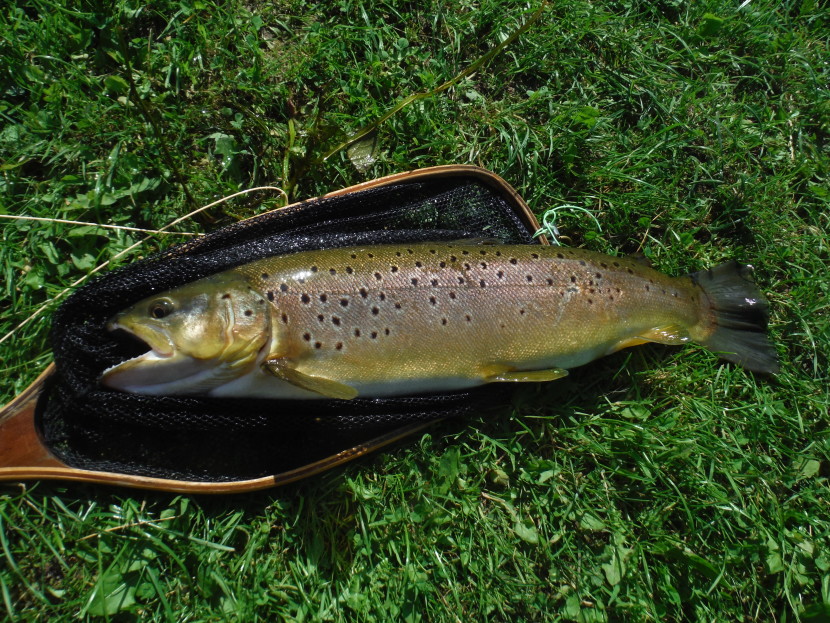 Last of the season
Last of the season 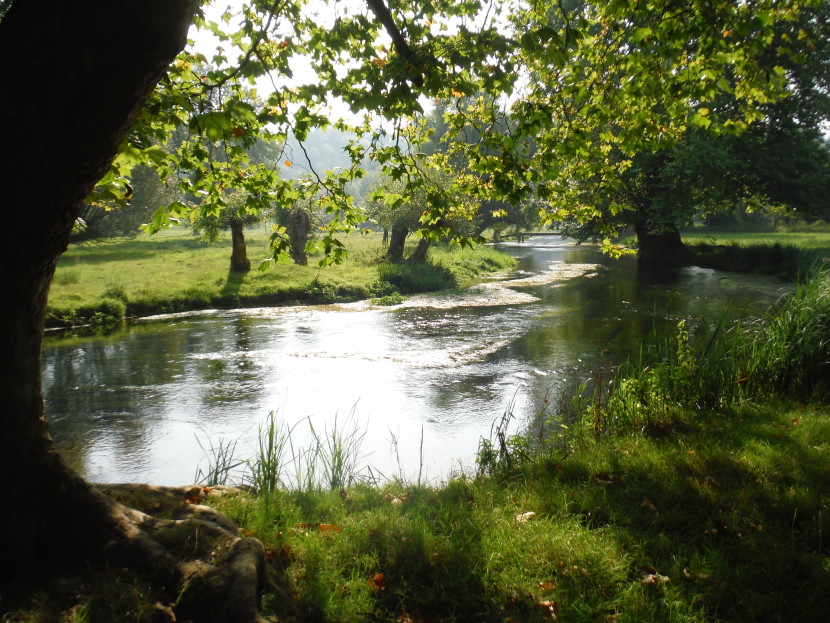 After the weed cut
After the weed cut Several syndicate members turned up for evening fishing about this time, so I confined myself to the deep churning pool below the Turbine hatch for our final hour or so. The generating turbine by the way, which once supplied electricity to the House, was removed many years ago, but the hut which housed it and the hatches and dam which produced the head of water remain. This pool is normally difficult because everybody has a cast here before or after eating lunch on the table beside it, and thus the fish get somewhat cautious. However you can see looking from the high bank into the depths where there are scoured white patches on the chalky bottom that there are big fish cruising in it and with the nymph cast up into the flow and allowed to run deep, it was possible extract several more. I ended the day with 13 trout, of which probably 4 were wild, and 9 were stock fish to over 22 inches, plus a grayling and a dace. David had stayed upstream and faithful to the dry fly, accounting for a dozen grayling and a trout.
We visited again a week later during the new heat wave, with the weed cut now accomplished. It had been a 14 hour day for Peter, but in fact the operation had gone more or less to plan. The weed cutting contractor, who has a boat looking rather like some kind of amphibious tank, had produced a mass of floating cut material covering the entire surface of the upper section below Woodford Bridge; in practice this had all sucked down through the Turbine hatch without too much trouble although the piers of the Brick Bridge below the House had needed clearing a few times. Downstream it was all grabbed out to be spread on fields. According to Peter, the trout had not been unduly disturbed by all this disturbance and were rising shortly after the weed cutting boat had passed. However, the trout certainly were not rising much on this day of glaring sun and air temperatures in the high 20s. The humid air drifting slowly from the south was breathless and still. Our cars that morning had acquired a light coating of fine Sahara dust and the sun, both in rising and falling, was almost obscured by a brown stain. You could look at the pale disc without pain through the hazed atmosphere. David pressed on with surface fishing again, rose some grayling and caught just one trout. I quickly gave up on the dry fly after showing it unsuccessfully to a few fish, changed to nymph and then caught trout all day together with just one grayling and a small dace. The 6 inch dace was attacked by one of the stock trout as it was drawn in to hand.
Seven hours was enough fishing for one day and I spent the early evening sitting in the green valley with the chocolate box thatched cottages of Woodford in the distance, just watching and listening to the clear Avon as it flowed. The Turbine hatches make some peculiar noises; if you listen closely while sitting there you can hear strange rumblings and dull bumps under the roaring waters. Peter came by for a chat; it was his son Ben’s second day at Agricultural College. As you might expect, the Avon Valley is usually a pretty quiet place, but now and again a disturbance comes to spoil its quiet rhythms. I heard that just before the heat wave, a large group of travelling folk “from across the water” arrived suddenly to park their caravans on the Amesbury recreation ground. Various disruptions followed. Twenty of the younger travellers already in a merry condition arrived at the pub by the Woodford Bridge, ordered a large number of drinks which they did not pay for, milled about on the bridge blocking and harassing the traffic, threw their empty glasses into the water, and finally got out no less than 8 rods to spin the river. They didn’t get very much result from the fishing attempt because Peter had wisely taken care that the weed immediately below the bridge had not been cut and also because about this time the police arrived in numbers and closed the road. What followed was not so much a poaching offence, but disorderly behaviour or a minor riot during which a number of police were sworn at, threatened and jostled. Later the police went to recover two stolen caravans at the Amesbury recreation ground camp and there was more threatening behaviour and more trouble during which a police car’s lights were broken. To everybody’s relief, this particular group of travellers moved on a couple of days later.
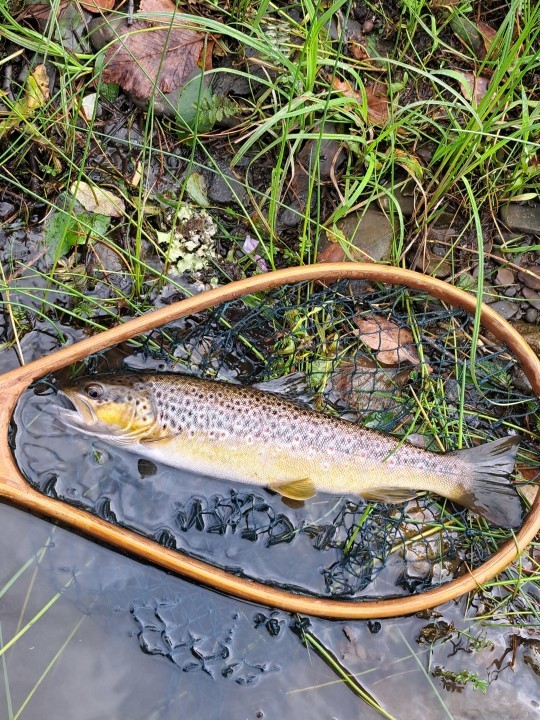 Abernant trout - SR from Llangynidr
Abernant trout - SR from Llangynidr More than desert dust now, but some news of real drama was arriving from the Sahara: an earthquake in Morocco and devastating floods in Libya. Even in warm water and while the hot weather lasted good catches of chub and barbel were being reported from the middle Wye. On the 10th PS from Southam with his son caught 40 chub and 5 barbel, including a double figure fish, from Caradoc. AT from Basingstoke fishing alone at Fownhope 5 recorded 42 chub to 5 pounds 2 ounces along with 2 eels, one of which was caught on the float. Away from the Wye KN from Weston Rhyn fished the Taff at Merthyr Tydfil and reported 14 trout taken on nymphs, while SW from Normanton fished the Dee at Llangollen Maelor for 20 trout and 5 grayling. Then very slowly the heat wave reduced; the WUF restored first trout fishing on the main rivers and finally on 13th September restarted salmon fishing. NG from Bampton took 13 chub at Lower Carrots and Luggsmouth, trotting meat with a centre pin. Gromaine member MH from Swansea had 6 trout and 16 grayling with nymphs. Some showers were beginning to have an effect and SN from Abingdon fished a slightly coloured Irfon at Cefnllysgwyne, catching 7 trout to an impressive 20 inches on dry flies. Others on the Wye enjoyed, or didn’t enjoy, their planned fishing day even when the results seemed to be similar. AT from Basingstoke fished at Lower Canon Bridge for 1 barbel and 8 chub: “…excellent day’s fishing on my favourite Wye and Usk beat.” MO from Bromley with a friend was on Caradoc, reporting 4 barbel, 12 chub and 1 “other” (an eel perhaps) and complained: “2 rods all day not very good.” PB from Churchdown with a friend did enjoy themselves with an excellent day at Doldowlod, catching 5 trout to 16 inches and 23 grayling to a memorable 19 inches. They fished the beat from top to bottom with dry flies. GB from Machynlleth caught 7 trout and 7 grayling at Gromaine, mostly on a Pink Shrimp at the tail of the Ferry. Member MH from Swansea “explored some of the less fished water” of the same beat and reported 9 trout and 3 grayling. I like that expression: “a water less fished,” it sounds like a Robert Frost poem. We could use some more access to water less fished. SR from Llangynidr caught 9 trout and 4 grayling on spiders at Abernant.
RW from Penrith had a barbel of 8.5 pounds from the Home Fishery, but was disappointed with the limited opportunities there for wading and trotting a float. This is true of much of the lower Wye, were many banks are steep and lead directly into deep water. Of course such swims are not a problem for a ledgering angler sitting above with a long handled net, but I suggest if you don’t know the river and have a particular method in mind, it might be wise to ring the WUF for advice. Something suitable is usually available and RW might have enjoyed wading and trotting at Wyebank for example. Something similar happened to AY from Birmingham with two friends who had problems with replacement knee joints and eventually fished for trout at Chainbridge. Other easy access choices for the Usk where a car can be driven close might have been Greenbank, Dinas or Abercynrig and in fact the Breconshire Fishery and Abergavenny Town Water are also relatively approachable.
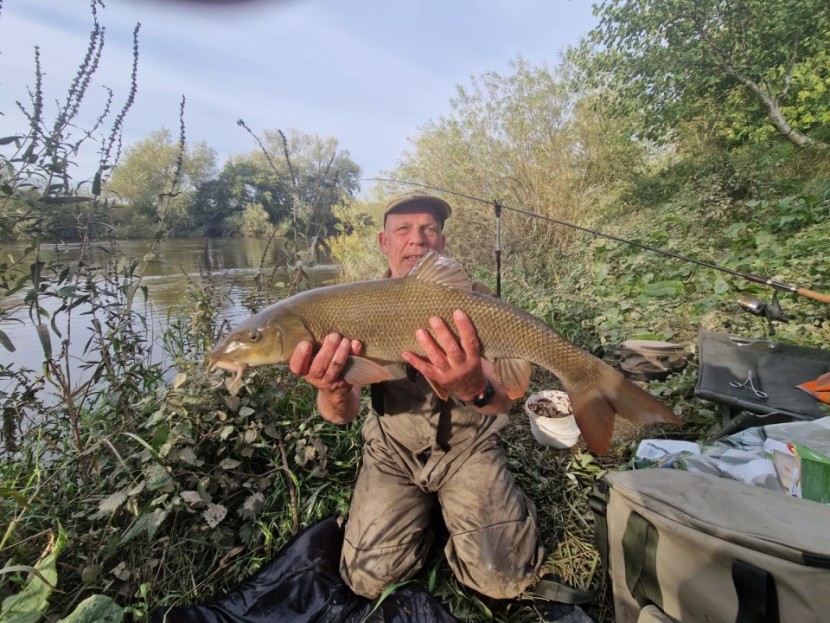 Fownhope 5 - NJ from Bedfordshire
Fownhope 5 - NJ from Bedfordshire 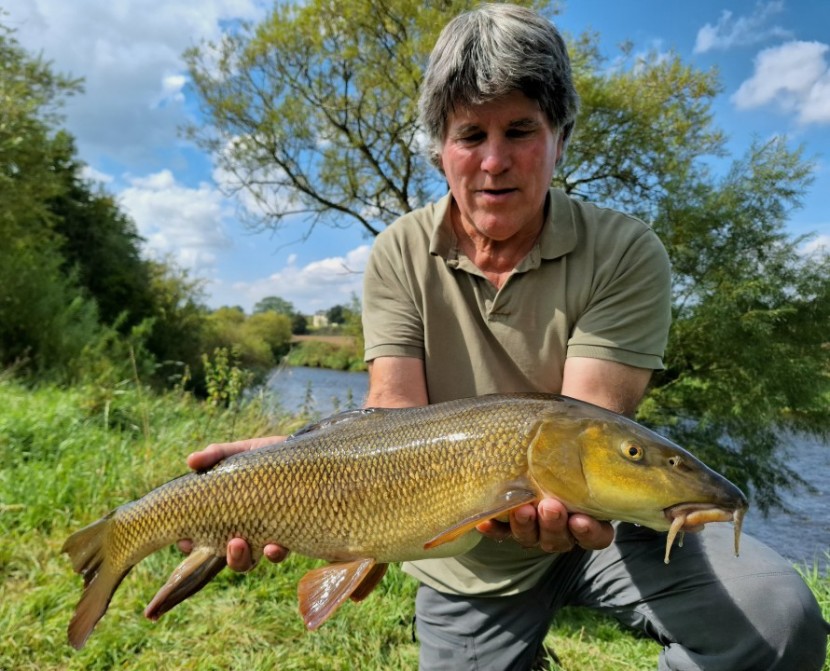 Foy Bridge barbel - NE from Chipping Norton
Foy Bridge barbel - NE from Chipping Norton 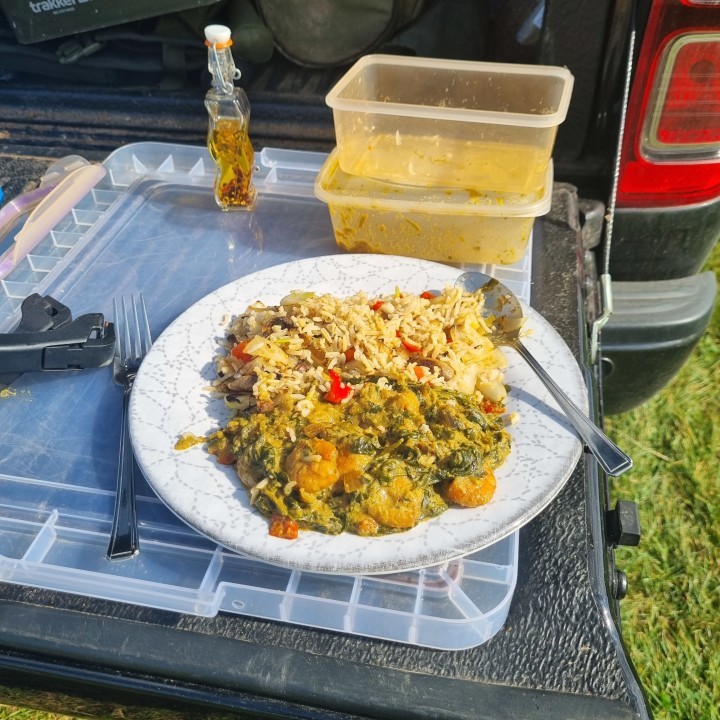 Prawn and spinach balti - MH from Wolverhampton
Prawn and spinach balti - MH from Wolverhampton AC from Stanford le Hope with three friends had an interesting day at The Creel catching 5 barbel to 6 pounds 8 ounces, 44 chub to 5 pounds 4 ounces and a common carp of 10 pounds 8 ounces. Carp do turn up from certain parts of the Wye on occasions. JM from Crowborough with a friend had 7 barbel and 82 chub at Fownhope 5. He rightly reflected that a catch of nearly 250 pounds of chub between two anglers is something quite remarkable. The Wye must be providing some of the best coarse fishing now available in the UK and I have to note with pleasure that nearly all the reports are signed off by visitors to our area. The weather was definitely changing now, sun and heat giving way to cloudy skies and drizzling showers. GT from Llandrindod Wells had a small sea trout in a catch of browns from the Aberystwyth AA’s water of the Rheidol. MH from Wolverhampton took 5 barbel and 15 chub at Caradoc, exchanged banter with a wild swimmer and treated us to the photograph of a prawn and balti picnic lunch on the tailgate of his car. AW from Ledbury again, fishing with a friend at Ty Newydd, countered this report with something called Waller’s Gala Pie which they consumed for lunch as an alternative to a pizza at the Griffin. They caught 9 trout and 7 grayling by the way. Later still, during a difficult day on Melyn Cildu, they were apparently reduced to a Tesco Polish Sausage, which seems like a bit of a come-down. NJ from Cwmbran reported 6 trout and 11 grayling from Gromaine and Upper Llanstephan using a Pheasant Tail Nymph. HP from Johannesburg caught 19 trout on dry flies from the River Greta in Cumbria. MW from Ross on Wye with 3 friends had another massive catch at Holme Lacey 3 and Lechmere’s Ley, with 4 barbel and 93 chub mainly between 3 and 4 pounds. AS from Malton with a friend fished at Strangford and caught 7 barbel to 8 pounds 1 ounce, 32 chub to 4.5 pounds and an eel of 2.5 pounds.
At short notice I had a morning to myself fishing the upper Monnow close under the Black Mountains. Despite all the rain, the Monnow never rose this month, as sometimes happens when all the weather is coming out of the West.
Conditions looked good on a warm day with thick cloud cover, but although some willow flies were in evidence, very few fish were rising. I was using the little 8 foot rod with a long leader and a size 16 Grayling Steel Blue on the point. I did get one 14 inch trout, which was lying just under the surface sipping very gently but regularly where the current ran into a deep rocky hole. The fish had that beautiful reddish gold colour which must come from lying over Monnow sandstone. More encouraging to find, however, were a couple of 10 inch fish caught in fast shallows – some indication of regeneration on a section of river which has been suffering from a lack of wild trout in recent years.
Meanwhile, the pickup was slow in the case of salmon fishing, although the weather for it was now about perfect: low cloud and soft grey light, with light rain at times. In the case of the lower Wye I found the water temperature on the 16th still holding at 17 and 18 degrees. On this day another of my clients was unlucky at Goodrich Court, this time in Dog Hole, losing a hooked fish during play. So much for barbless hooks was my immediate thought, plus the undeniable fact that Goodrich could do with a few salmon in the book this year.
Wyesham reported a fish of 9.5 pounds on the 18th, and from a friend I received a photograph of a harvest sewin of 8 pounds taken on the fly at night from the Loughor. Otherwise the rivers were beginning to rise now due to repeated showers. NH from Chilworth near Guildford caught 2 trout and a grayling at Llangoed and Lower Llanstephan. It’s many, many years now since I caught a wild trout from the Tillingbourne at Chilworth, but I can remember its pale greenish colouring to this day. GEM Skues used to fish the same little stream between the chalk downs and greensand Weald. Another Surrey angler, MC from Woking led a party of six anglers to Whitney Court on the 19th; their catch of 3 barbel and 9 chub was modest, but they recommended their accommodation at The Agents House.
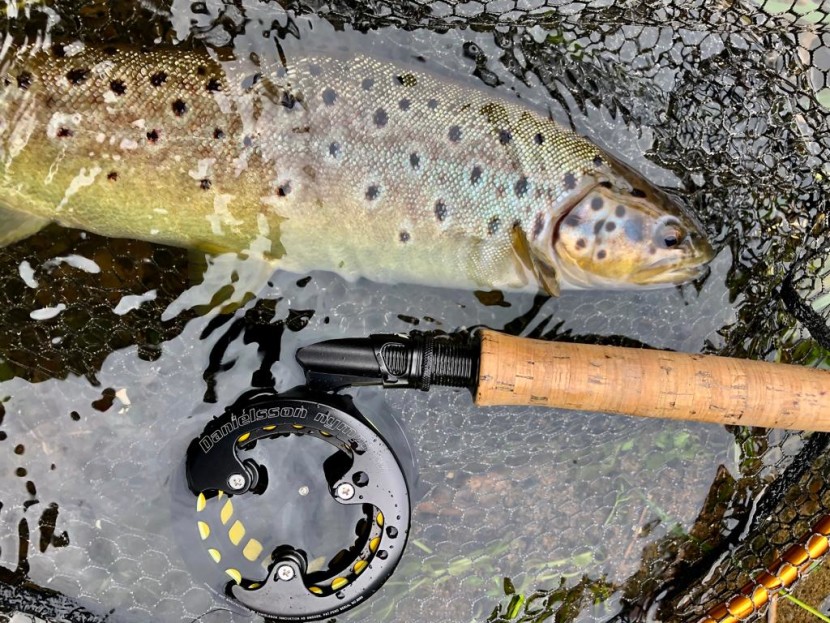 Loughor brown trout - Lyn Davies
Loughor brown trout - Lyn Davies 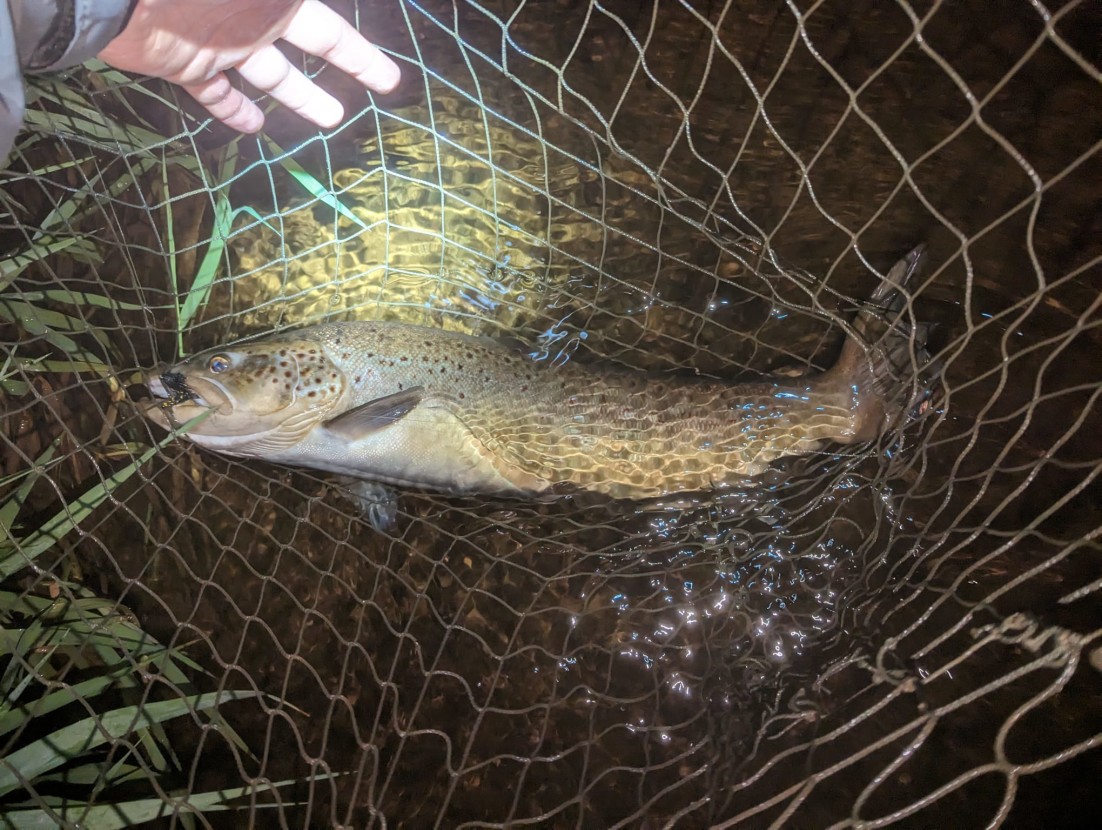 Harvest sewin - TL of Pontardulais
Harvest sewin - TL of Pontardulais In this period marked by thunder storms and wet stormy weather, I spent one warm and dark evening sitting out on the porch with a glass or two of wine while watching the rain fall. I was thinking back to a similar stormy late season night on the Loughor when I caught a 9 pound sewin on the fly and I had the sudden thought that this might be just such a night to start the adult eels on the move. I notice a few big ones have been caught on bait by anglers lately. Not many people these days get to see the migration of silver eels which happens in the autumn season, although once they would have been intercepted for the market. I can remember the eel trap weir in Blakeney village which caught adults leaving the Forest for the Severn. Eels are mysterious fish and sadly much rarer than they used to be. They love darkness and are essentially creatures of the night, but they also seem to have an affinity with electricity in the atmosphere. On thundery days in August I have sometimes found them lying out exposed in the streams and this seems to be some kind of prelude to migration. After maybe a decade in fresh water, from ponds and ditches, often crossing wet grass in the darkness, the adult eels due to spawn in the Sargasso Sea will be heading down tributary streams and main rivers, eventually reaching the ocean, never to return. Atlantic eels weighing 10 pounds and as long as 4 feet have been known, but normally a yard is the limit for a big female.
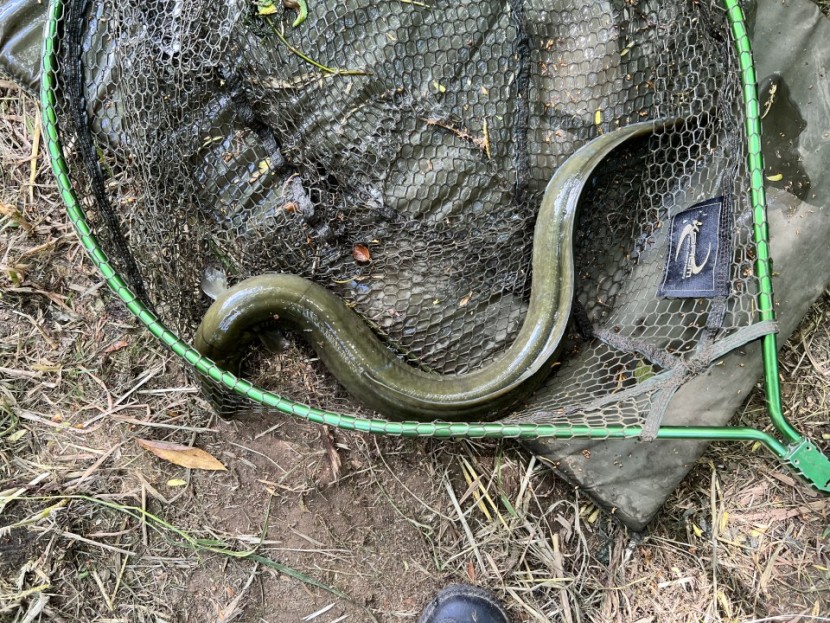 Yellow eel - AS from Roydon
Yellow eel - AS from Roydon 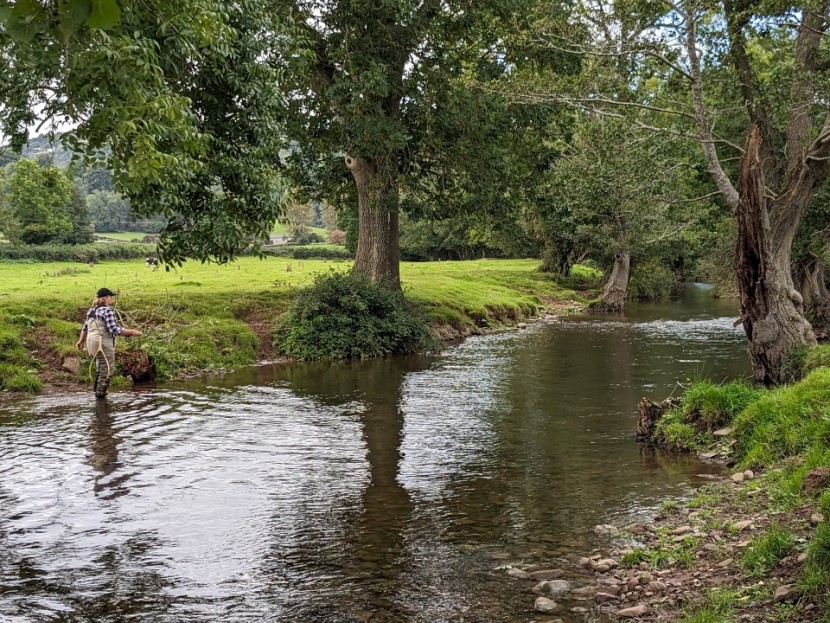 Honddu Lower Stanton - CT from Cardiff
Honddu Lower Stanton - CT from Cardiff 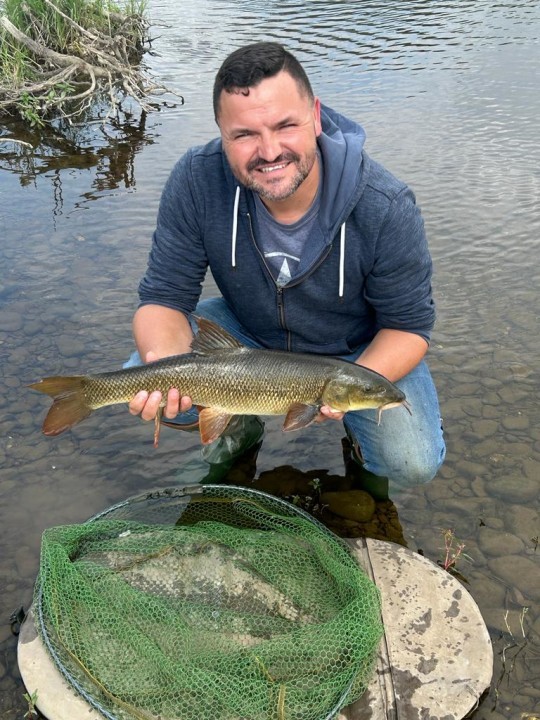 Whitney Court - MS from St Neots
Whitney Court - MS from St Neots By September 20th, which was another day of wind and rain and which I spent indoors tying flies in a spirit of optimism about future salmon (one can hope), both rivers had a proper flood under way. A couple of metres of extra water were now pouring down from central Wales. My local Forest streams had not moved much and nor had the Monnow, but clearly the rain in the Cambrian Mountains must have been really heavy. The EA issued flood warnings for low lying roads and properties first in Hay, then Ross and Lydbrook as the rise made its way downstream. MC from Woking with his 5 friends gave up their fishing at Whitney when the waters were already rising fast and “…we saw farmers herding cattle away from the area.” LM from Neston with a friend caught 88 chub at Strangford, but again the river was rising rapidly. BA from Epsom with 3 friends were just ahead of the game at Middle Hill Court and beat the rise to take 43 barbel and 21 chub.
On the 21st PT from Mordiford managed to fish the Dean and Chapter although the river had risen 10 feet overnight, catching 2 barbel to 8.5 pounds and a chub. TM from Ballyhalbert reported from Whitney Court: “Washout…river had burst its banks…attempted to fish…but flow was too heavy.” TT from Tillingham tried the Lugg at Tidnor which was less affected by flood water and had 5 chub from 2.2 to 4.4 pounds. Away from swollen rivers, HJ from Bridgend fished at Teifi Pools, taking 4 trout from Egnant and 4 from Teifi, using classic top dropper flies, Sedgehog, Bibio and Mini Muddler. RL from Westbury enjoyed himself at the Beacons Reservoir which had been refreshed by an inflow of cool water and caught 5 trout to 1.5 pounds on dry sedge patterns.
The next few days proved unusually difficult on rivers as several weather fronts and bouts of heavy rain passed over us from the Atlantic. There were complaints that the rise of the Wye had been exacerbated by a sudden release from the Elan Valley dams. The water levels of both rivers began to drop off and then suddenly rose again after more overnight rain. The Irfon was up. However, some of the other tributary streams hardly rose at all. The Monnow system coloured slightly but otherwise seemed unaffected by the rain. CT from Cardiff with a friend had 19 trout and a grayling from the Honddu at Lower Stanton. Many of the coarse anglers were able to take barbel and chub on the middle and lower Wye despite high water levels. A couple of salmon turned up during the period of run-off: a 12 pounds hen taken on a Cascade by Brett Fleming-Jones at Llanover and a two sea winter cock salmon taken by Alan Ward from Worcester with a Phatagora Fly from the gutter below Chapel Catch at Llangoed. One fish from the Usk and one from the Wye were some kind of encouragement. Stuart Macoustra lost a fish in the Rock Pool at Chainbridge after a minute of head-shaking. RL from Westbury had a “really enjoyable day” in a strong SW wind on the Beacons Reservoir. He caught 8 trout on a dry sedge pattern in choppy water. Looking north for a change, JM from Liverpool caught 19 trout from the Raby Estate water of the Tees on spiders, mostly Greenwell’s Glory and Snipe and Purple. We heard about more lost salmon: MH from Swansea lost two fish hooked on the Rectory on the 27th, one in the Bridge Pool and a big one in Gravel Catch within a couple of yards of the net. Barbless hooks again? MR from Whitland reported a pike while he was fishing the Dean and Chapter for salmon with a Rapala lure. And why were you fishing the Wye for salmon with a Rapala lure during September please sir? Unless I missed the rules changing, spinning goes 3rd March to 31st August, and it’s fly-fishing after that to the season end. On a more positive note, Wyesham reported a coloured cock fish of 22 pounds taken on the 28th.
Welcome news from the WUF is that the Pontithel beat of the Llynfi is now back in play and available to fish. This little wild stream tributary has been exceedingly unlucky in recent years, having experienced not one but several pollutions and fish kills from anaerobic digester waste being spread on nearby farmland. No prosecutions resulted from these events. It used to be an excellent fishery with both trout and grayling, including big ones at times, plus some slight oddities such as small pike which must have originated from the Llangorse Lake which feeds it. Now we understand this stream has been naturally repopulated after three years standing idle; it would be nice to think there will be no further accidents, but I am not holding my breath. AP from Wirral is one who tried it and found the river still very low, but saw a number of different species plus many signal crayfish.
 Monte Carlo stock and parallel comb to the rib
Monte Carlo stock and parallel comb to the rib On yet another evening of dark clouds threatening more showers, I went down to the estuary to join some of the local wild-fowlers who have a little club shooting trap targets after work. This meeting would be the last of the summer as the nights are now drawing in. As usual I shot a couple of turns of Down the Line with the trap gun, which has a Monte Carlo stock with parallel comb and a high rib. Rather than delivering the shot to the point of aim, by design it shoots rather high. This combined with a long barrel and a tight choke is just what is needed with the rising and receding targets of the trap discipline, but to be quite honest, isn’t much use for anything else. It’s amazing how sensitive trap shooters get to be about their environment, the background, the colour of the glasses they are wearing, and whether there is a wind or not. The background in this case consists of a few grassy mounds, beyond that the estuary, a mile of water or shining sand depending on the tide, a distant shoreline and then the end of the blue Cotswolds defining the horizon. Occasionally on the far side of the river there might be a freighter heading upstream for Sharpness. When shooting these targets in the evening the dying sun sinking into the hills behind us poses no problem, but it would be near impossible facing east into the glare of the early morning Trap shooting is a high concentration sport and on this particular evening people were complaining about the small black flies buzzing around the area. I didn’t mind the flies which tend to follow the cattle but after a pretty modest score I reminded myself to concentrate harder and attend more often next year. Meanwhile some of the younger members were playing a different game with three cartridges loaded in semi-automatic guns, and in which an erratic target from an oscillating trap is combined with predictable loopers coming from right and left. This is exciting stuff with three targets in the air together and you need to shoot quickly, but of course you get through an awful lot of cartridges. The lights were already winking on across the estuary as we packed up.
That’s all for the 2023 trout season, with the exception of an extra week on a few Severn tributaries. A couple more weeks for the salmon and then we will be left with the grayling and the coarse fishing until next spring. Tight lines!
Oliver Burch
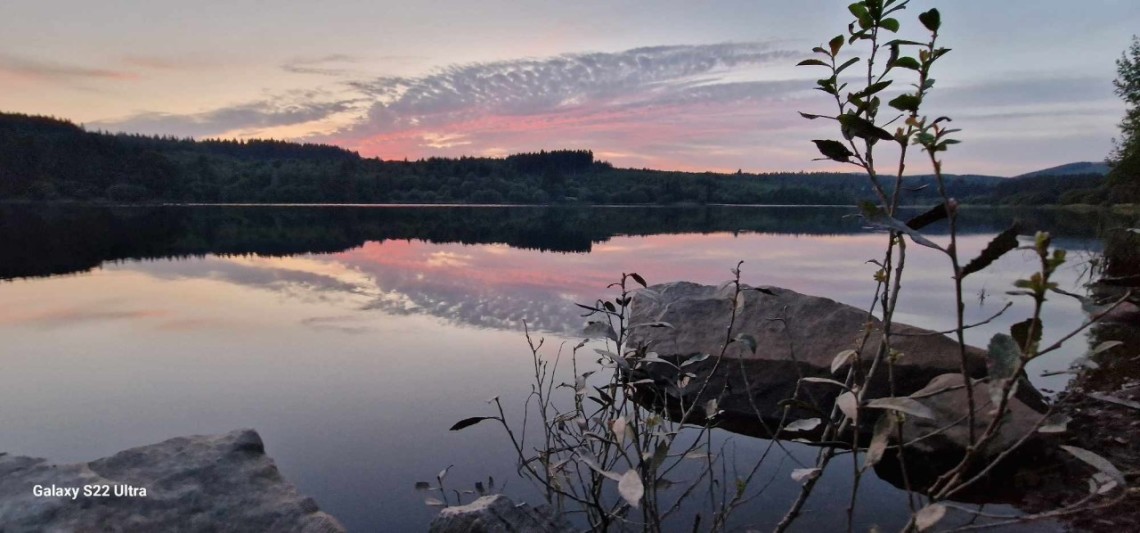 Llwyn On - JB from Cardiff
Llwyn On - JB from Cardiff